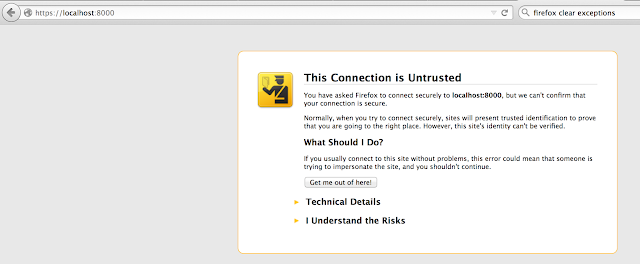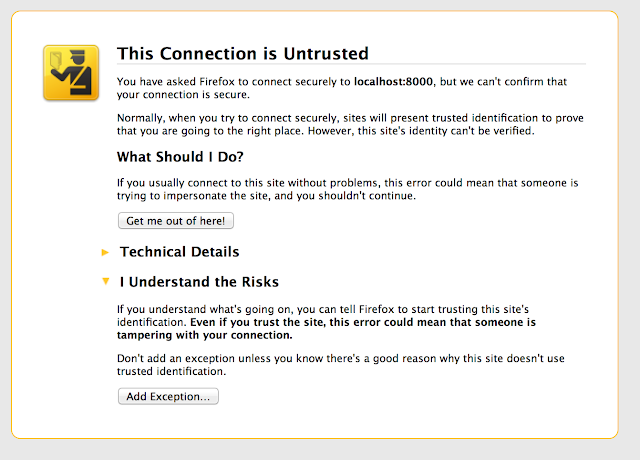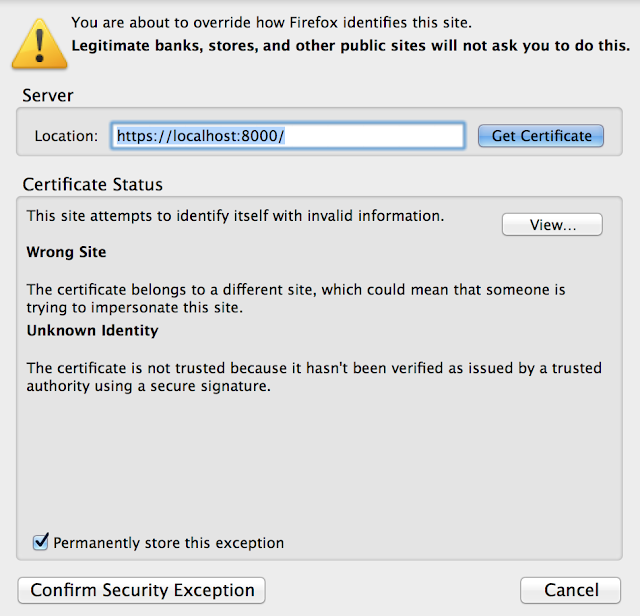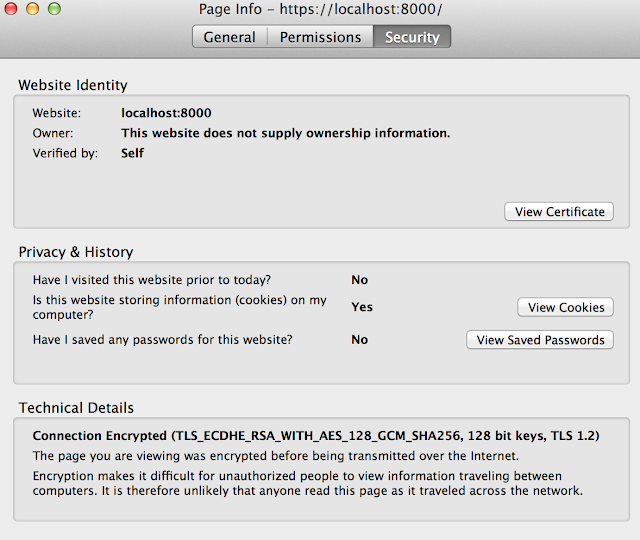Objective: Objective of this
document is to demonstrate how browser behaves when making a cross
origin resource request.
Step 1: Go to the UI project. DynamicDataUI
Step 2: Start it
Step 3: Start the data service
Step 4:
Ensure the back end
service(NodeJsPostgresDynamicData) is working. Note the url. Basically the page resides in the same module as the back end service so there is no cross site request made.
You will get lot of popups click ok on
all.
Step 5:
Ensure sorting
by client works.
[TODO-Confirm]When
fewer than 10 rows no call is made to the server. Watch it in the
console.
Step 6: Now try the CORS on
firefox.
Error: Cross-Origin Request Blocked:
The Same Origin Policy disallows reading the remote resource at
http://localhost:3000/api/v1/invoicesMetaData?_search=false&nd=1432587205781&rows=10&page=1&sidx=c2&sord=desc.
(Reason: CORS header 'Access-Control-Allow-Origin' missing).
Error from UI Server console.
maheshs-mbp-2:DynamicDataUI
maheshrajannan$ node bin/www
::1
- - [25/May/2015:20:53:24 +0000] "GET /DynamicHeaderProperties
HTTP/1.1" 200 12244 "-" "Mozilla/5.0 (Macintosh;
Intel Mac OS X 10.9; rv:38.0) Gecko/20100101 Firefox/38.0"
::1
- - [25/May/2015:20:59:22 +0000] "GET /DynamicHeaderProperties
HTTP/1.1" 200 12244 "-" "Mozilla/5.0 (Macintosh;
Intel Mac OS X 10_9_5) AppleWebKit/600.6.3 (KHTML, like Gecko)
Version/7.1.6 Safari/537.85.15"
::1
- - [25/May/2015:20:59:23 +0000] "GET /favicon.ico HTTP/1.1"
500 1637 "http://localhost:8080/DynamicHeaderProperties"
"Mozilla/5.0 (Macintosh; Intel Mac OS X 10_9_5)
AppleWebKit/600.6.3 (KHTML, like Gecko) Version/7.1.6
Safari/537.85.15"
Error:
Failed to lookup view "error" in views directory
"/Users/maheshrajannan/Samples/Workspaces/nodeJs/Project/DynamicDataUI/views"
at
EventEmitter.app.render
(/Users/maheshrajannan/Samples/Workspaces/nodeJs/Project/DynamicDataUI/node_modules/express/lib/application.js:519:17)
at
ServerResponse.res.render
(/Users/maheshrajannan/Samples/Workspaces/nodeJs/Project/DynamicDataUI/node_modules/express/lib/response.js:933:7)
at
/Users/maheshrajannan/Samples/Workspaces/nodeJs/Project/DynamicDataUI/app.js:51:9
at
Layer.handle_error
(/Users/maheshrajannan/Samples/Workspaces/nodeJs/Project/DynamicDataUI/node_modules/express/lib/router/layer.js:58:5)
at
trim_prefix
(/Users/maheshrajannan/Samples/Workspaces/nodeJs/Project/DynamicDataUI/node_modules/express/lib/router/index.js:300:13)
at
/Users/maheshrajannan/Samples/Workspaces/nodeJs/Project/DynamicDataUI/node_modules/express/lib/router/index.js:270:7
at
Function.proto.process_params
(/Users/maheshrajannan/Samples/Workspaces/nodeJs/Project/DynamicDataUI/node_modules/express/lib/router/index.js:321:12)
at
IncomingMessage.next
(/Users/maheshrajannan/Samples/Workspaces/nodeJs/Project/DynamicDataUI/node_modules/express/lib/router/index.js:261:10)
at
fn
(/Users/maheshrajannan/Samples/Workspaces/nodeJs/Project/DynamicDataUI/node_modules/express/lib/response.js:928:25)
at
EventEmitter.app.render
(/Users/maheshrajannan/Samples/Workspaces/nodeJs/Project/DynamicDataUI/node_modules/express/lib/application.js:521:14)
Step 7:
Try the same in
safari.
Step 8:
Now the fix on
the UI side (DynamicHeaderProperties.html)
Step 9:
Now the fix on the server side.
Basically to allow it to send jsonp requests.
Just one character change.
Res.json( to → res.json
p(
Short Notes:
This simply means we are bypassing the
security provided by the browser. It is therefore not
recommended(Ref:2). What it tells the browser is this is a script and
instead of executing the script, it loads the json data. The final
conclusion from the article is as follows
“
These days,
CORS
is the recommeded approach vs. JSONRequest. JSONP is still useful for
older browser support, but given the security implications, unless
you have no choice CORS is the better choice.
“
Quotes from the article
“
The one item that bypasses this
limitation is <script> tags. When you use a script tag, the
domain limitation is ignored, but under normal circumstances, you
can't really DO anything with the results, the script just gets
evaluated.
Enter JSONP. When you make your request to a server that is JSONP
enabled, you pass a special parameter that tells the server a little
bit about your page. That way, the server is able to nicely wrap up
its response in a way that your page can handle.
It's also worth noting the one major issue with JSONP: you lose a
lot of control of the request. For example, there is no "nice"
way to get proper failure codes back.“
Step 10:
Doing it the right way. Using fine
grained CORS support, so that server can control if the request can
be served or not, on the basis of specific domain.
I am working on to clean up my code and
I will publish the code, after that. This is written using node js
and grid is written using jqgrid.
References:
-
-
-
The End

































